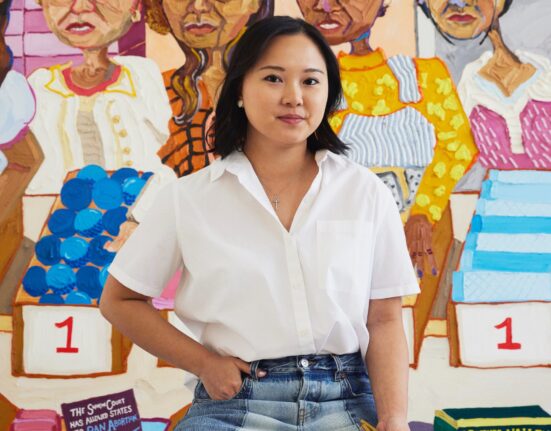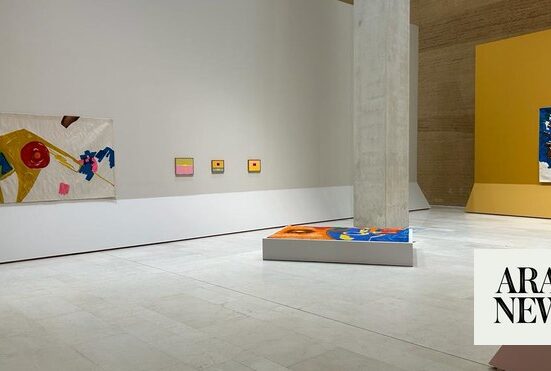July Papatsie, an Inuk carver, spoke about his work and demonstrated how he does his soft stone and bone carvings at the Isaruit Inuit Arts space in the Rideau Community Hub in Ottawa on April 11.Ashley Fraser/The Globe and Mail
In his sun-drenched workshop in Ottawa, July Papatsie chips away at a carving of an inuksuit, the well-known stone formations used by Inuit as landmarks and guideposts.
Around here, he’s known for always having a story to tell, and can often be found chatting with fellow Inuit carvers who share the workshop located inside a former high school.
The 64-year-old Ottawa-based artist from Pangnirtung, a hamlet in Nunavut located 40 kilometres south of the Artic Circle, was introduced to the power of carving when his father handed him a piece of a rock called serpentine when he was 8.
“He gave me a big chunk and told me to make a seal,” he says.
When Papatsie was 12, he was drawn to carve inuksuit after spending time on the land with his father, who taught him the markers are a “survival tool” used to spook caribou into moving toward a lake where a hunter would be waiting on a kayak with a knife.
Today, his craft remains an anchor in his life. “When you’re carving, you forget about everything else.”
Papatsie carries painful memories from when he attended day school in Pangnirtung, where he says he was subjected to sexual abuse. Carving helps him cope, and also helps him keep his commitment to sobriety.
He considers the inuksuit his specialty, and he makes them in various sizes. Some are smaller than an inch, while others are much larger. He says he once made one the size of a person.
One of Papatsie’s Inuksuk is on display at Rideau Community Hub.Ashley Fraser/The Globe and Mail
It takes him several hours to carve most of his inuksuit, which he may then be able to sell for a couple hundred dollars to a local gallery.
But Inuit artists like him face a significant problem.
At tourist shops, airports and hotels across the country, imitations of Inuit art are sold, undermining Inuit artists’ livelihoods. Natan Obed, president of the Inuit Tapiriit Kanatami – a national non-profit that advocates for Inuit priorities – is calling for government to consider a legislative response.
Obed, who has served in his role as president since 2015, says thousands upon thousands of tourists have purchased inauthentic pieces in Canada, which they assume to be Inuit art but are often imported from overseas.
Retailers who profit off the sale of these pieces are “making money off of our likenesses, our art, our people, our cultural practices,” says Obed.
Indigenous art fraud has been in the spotlight, including most recently the discovery that pieces attributed to First Nations artist Norval Morriseau were fraudulent. But as we wait for those criminal trials to take place later this year, Obed says more attention needs to be paid to the widespread sale of inauthentic Inuit art.
This problem, he says, has persisted for decades – and experts believe it only worsened following the 2010 Vancouver Olympics, whose logo was a representation of an inukshuk.
While the United States has taken legislative steps to deter the misrepresentation of Indigenous art, that’s not the case in Canada.
“I just get the sense that some people feel like the problem is too big or that there are no resources or tools – legislative or otherwise – to be able to hold anyone to account for what is taking place,” says Obed.
“Ultimately, it is another way of taking our identity, our opportunities and our cultural expressions.”
Papatsie currently uses more power tools in his day-to-day creations but still has the ability to make his creations by hand as well.Ashley Fraser/The Globe and Mail
Piita Irniq, who represented the Keewatin region in the Council of the Northwest Territories, and served as a commissioner of Nunavut, says that “we Inuit have always carved, since time immemorial.” His late mother Irene Kataq Angutitok was a sculptor.
When he campaigned to be an MLA for the Keewatin region in 1975, he spoke about wanting to ensure that Inuit carvings were not mass-produced by manufacturers. “We did not get much attention for our issues in those days,” he says, and so the imitations persist.
“It’s happening all over, and it’s got to stop. They do not represent Inuit. They’re not made by Inuit. They are not authentic.”
To underscore how prevalent the issue of inauthentic Inuit art is, Obed recalled a discovery made at the Anima Mundi, an ethnological museum within the Vatican, which he visited in 2022 as part of a delegation sent to meet with the Pope to talk about the Catholic Church’s responsibility for the trauma caused by residential schools.
During that trip, items from the museum’s collection of Indigenous art were placed out on tables for the delegates to view.
While looking at a piece that was said to have been gifted to the Pope in the 1980s, Obed identified it as a “plastic piece from China,” and he informed the curator.
“I’m not sure what happened to it,” he says. “I think they were deeply embarrassed.” (The Holy See press office did not respond to multiple e-mails from The Globe).
Obed says he cannot quantify how many imitation pieces are sold every day in Canada, but he believes it is widespread and affects Inuit artists’ ability to feed themselves and their families.
Papatsie holds a narwhal tusk necklace he created.Ashley Fraser/The Globe and Mail
For example, in Cape Dorset, Nunavut (known as Kinngait in Inuktitut), up to half of all adults gain at least some of their livelihood through art. While that community has grown into a hub for Inuit art, influenced by the presence of famed artist James Houston, the percentage of those who rely on art in many other Inuit communities is around 20 per cent or higher.
According to Inuit Tapiriit Kanatami, about 70,000 Inuit live in Canada, often inhabiting small communities that have limited economic opportunities. Income from making and selling Inuit sculptures and prints has allowed them to live a traditional lifestyle and stay in their home communities.
Canada, Obed laments, doesn’t have the legislative structures to address this issue, or any penalties, such as those in place in the United States.
The U.S. Indian Arts and Crafts Act of 1990 makes it illegal to display for sale, or sell, any product that “falsely suggests” it is produced by an Indigenous person.
In 2023, Cristobal Rodrigo in Washington State, who sold products made in the Philippines as authentic Indigenous work produced in Alaska, was found to have violated the Indian Arts and Crafts Act. He’s now serving a two-year sentence in an Oregon prison, in what the U.S. Justice Department called a “monumental sentence.” It is the longest sentence issued for any violation of the Indian Arts and Crafts Act.
But it appears the Act has gone largely unenforced. The most comprehensive study available, a 2011 report by the U.S. Government Accountability office, said the extent of misrepresentation and the size of the market are unknown. From 2006 to 2010, 649 complaints were made by the Indian Arts and Crafts Board, the report said, adding that the board determined 150 of these complaints involved an apparent violation of the law. Of those, it referred 117 complaints for further investigation by law enforcement but no cases were filed in federal court as a result.
Jack Anawak, who represented the federal riding of Nunatsiaq in the House of Commons from 1988 to 1997, says Ottawa “has the muscle” to address this issue and could benefit from researching steps taken by the U.S.
He recalls a visit to Wasaga Beach in Ontario in the 1980s where he went into a shop that was selling what it labelled as “Eskimo art.” He says he told the shopkeeper that what she was advertising were not authentic and in response the owner became angry and threatened to call the police.
He left, dispirited by the interaction.
Papatsie hasn’t yet decided what he will create with this whale bone.Ashley Fraser/The Globe and Mail
When The Globe asked Canadian Heritage to respond to concerns about imitations of Inuit art, spokesperson Amy Mills wrote that since 2018, the government has spoken with Indigenous artists and experts to better understand the impacts associated with misuse and misappropriation. She also said Heritage has begun studying measures in other jurisdictions, including the United States. The department said there is no specific plan for a report related to activities in other countries.
Canada, meanwhile, has no import restrictions related to replica works of art, says Jacqueline Roby, a spokesperson for the Canada Border Services Agency.
In 1958, the government did attempt to promote authentic Inuit products by launching the Igloo Tag, a stylized igloo symbol that could be placed on an artwork to signify it is made by an Inuit artist. While experts believe this initiative doesn’t act as an adequate deterrence for imitations, a 2016 survey on the Inuit arts economy found that consumers did place a higher value on objects with the tag.
In 2017, the federal government handed over management of the Igloo Tag to the Inuit Art Foundation, a national non-profit organization focused on supporting Inuit art and artists. Alysa Procida, the organization’s executive director, says the foundation is currently reviewing the use of the Igloo Tag. She says the trademark has been helpful, but that “it’s not a foolproof or failsafe way of protecting intellectual property rights” and that enforceable legislation is still necessary.
Procida says because the U.S. Indian Arts and Crafts Act can result in fines for individuals mispresenting art as being made by Indigenous people, it provides a greater degree of protection for artists. Another benefit of legislation, she notes, is that compared with a tool like the Igloo Tag, it shifts the burden of responsibility from Indigenous organizations and non-profit groups in the arts, who have limited resources, to existing law enforcement structures.
“I am hopeful that legislation that protects Indigenous intellectual property, and specifically artistic practice that includes serious penalties for misrepresentation, will be implemented in Canada.”
Procida emphasized, however, that if legislation were implemented in Canada, it would be important to ensure that Inuit, First Nations and Métis governments take the lead.
For his part, Papatsie says that every time an inauthentic piece shows up on the market, it increases supply and affects prices – making it difficult for Inuit artists to earn a living. He hopes these imitators profiting off his heritage will one day receive fines for their “fake art” and envisions regulators being able to hand out tickets.
“Like something that’s not serious, but over time, could become serious, if you’re a repeated offender,” he says. “It degrades us a lot.”






